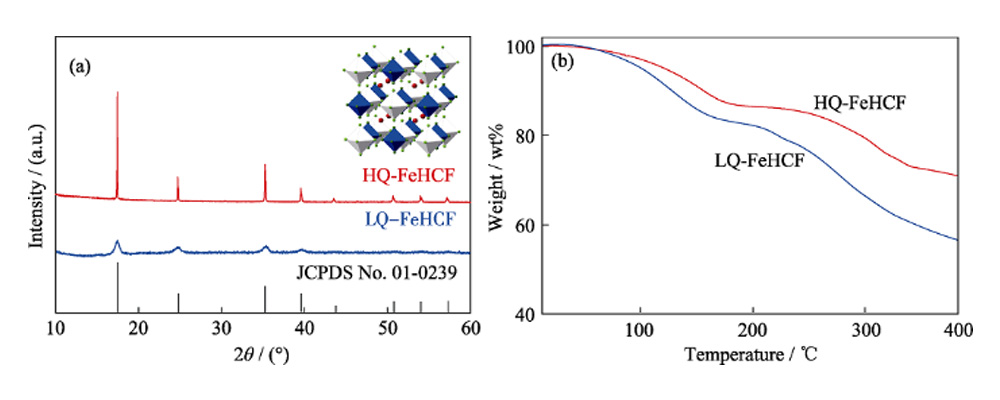High-quality Fe4[Fe(CN)6]3 Nanocubes Preparation: As Cathode Material for Aqueous Sodium-ion Battery
WANG Wu-Lian. High-quality Fe4[Fe(CN)6]3 Nanocubes: Synthesis and Electrochemical Performance as Cathode Material for Aqueous Sodium-ion Battery. Journal of Inorganic Materials[J], 2019, 34(12): 1301-1308 doi:10.15541/jim20190076
High-quality Fe4[Fe(CN)6]3 (HQ-FeHCF) nanocubes were synthesized by a simple hydrothermal method. Its structure, morphology and water content are characterized. Fe4[Fe(CN)6]3 exhibits regular cubic shape with a uniform size of ca. 500 nm, which belongs to the face-centered cubic phase. Fe4[Fe(CN)6]3 shows discharge capacities of 124, 118, 105, 94, 83, 74 and 64 mAh·g -1 at 1C, 2C, 5C, 10C, 20C, 30C and 40C rate, respectively, in the aqueous ternary electrolyte of NaClO4-H2O-Polyethylene glycol. Its capacity retention remains 100% after 500 charge/discharge cycles at the rate of 5C. The full battery with Fe4[Fe(CN)6]3 as cathode and NaTi2(PO4)3 as anode was fabricated, which delivers a specific energy density of 126 Wh·kg -1 (based on the active electrode materials) with a voltage output of 1.9 V. Furthermore, 92% of its initial discharge capacity retains after 140 charge/discharge cycles at a rate of 5C, and its Coulomb efficiency is close to 100%.
Electrode materials preparation
Using Na4Fe(CN)6 as a single iron source, high-quality Fe4[Fe(CN)6]3(HQ-FeHCF) nanomaterials were synthesized by a simple hydrothermal method. In addition, low-quality Fe4[Fe(CN)6]3(LQ-FeHCF) nanomaterials were synthesized by traditional methods for comparison, and the structure, morphology and electrochemical properties of HQ-FeHCF and LQ-FeHCF were studied. Finally, using HQ-FeHCF as the positive electrode, NaTi2(PO4)3 as the negative electrode, and NaClO4-H2O-polyethylene glycol (PEG) as the electrolyte, an aqueous sodium-ion full battery was assembled.
HQ-FeHCF and LQ-FeHCF preparation
At room temperature, 4 g of polyvinylpyrrolidone K-30 (PVP) and 0.126 g of sodium ferrocyanide decahydrate were added to 50 mL of aqueous hydrochloric acid at pH=0.8, stirred for 1 h, and the solution turned yellow when completely dissolved. Then, the uniformly stirred solution was placed in an oven at 80 °C for 12 h. The solution cooled to room temperature was centrifuged to obtain a precipitate and washed with deionized water. After repeating 4 times, the HQ-FeHCF sample was obtained by drying in an oven at 80 °C for 8 h.
Add 2.7 g of ferric chloride hexahydrate and 3.6 g of sodium ferrocyanide decahydrate into 100 mL of deionized water, respectively. Stir at 60 °C until the two solutions are completely dissolved. Then ferric chloride hexahydrate salt solution was added to sodium ferrocyanide decahydrate salt solution to generate a large amount of dark blue precipitate. After incubation at 60 °C for 1 h, the solution was centrifuged to obtain a precipitate, which was washed with deionized water four times, and then dried in an oven at 80 °C for 8 h to obtain the LQ-FeHCF sample.

The prepared electrode materials were mixed according to the ratio of m (active material): m (acetylene black): m (polyvinylidene fluoride (PVDF))=75:15:10. Add an appropriate amount of N-methylpyrrolidone (NMP) and stir for 8 h, and then spread the evenly stirred slurry on a circular titanium mesh with a diameter of about 1.3 cm. Dry it in an oven at 80 °C for 12 h, and then press it into a thin sheet with a tablet press under a pressure of 10 MPa to make a working electrode. A three-electrode system was assembled using platinum wire as the counter electrode and silver chloride as the reference electrode. The charge-discharge platform, rate performance and cycle stability of HQ-FeHCF were tested. A HQ-FeHCF electrode sheet with a diameter of 1.3 cm was used as the positive electrode (1.14 mg active material loading). The NaTi2(PO4)3 electrode sheet was used as the negative electrode (the active material loading was 2.73 mg). A full battery was formed for constant-current charge-discharge performance testing, and the constant-current charge-discharge voltage range of the battery system was 0–2 V. Electrode discharge capacity and battery energy density are only calculated based on the mass of the active material. The electrolyte uses NaClO4+H2O+Polyethylene glycol (PEG) system.
Learn more about sodium ion battery materials from TOB NEW ENERGY.